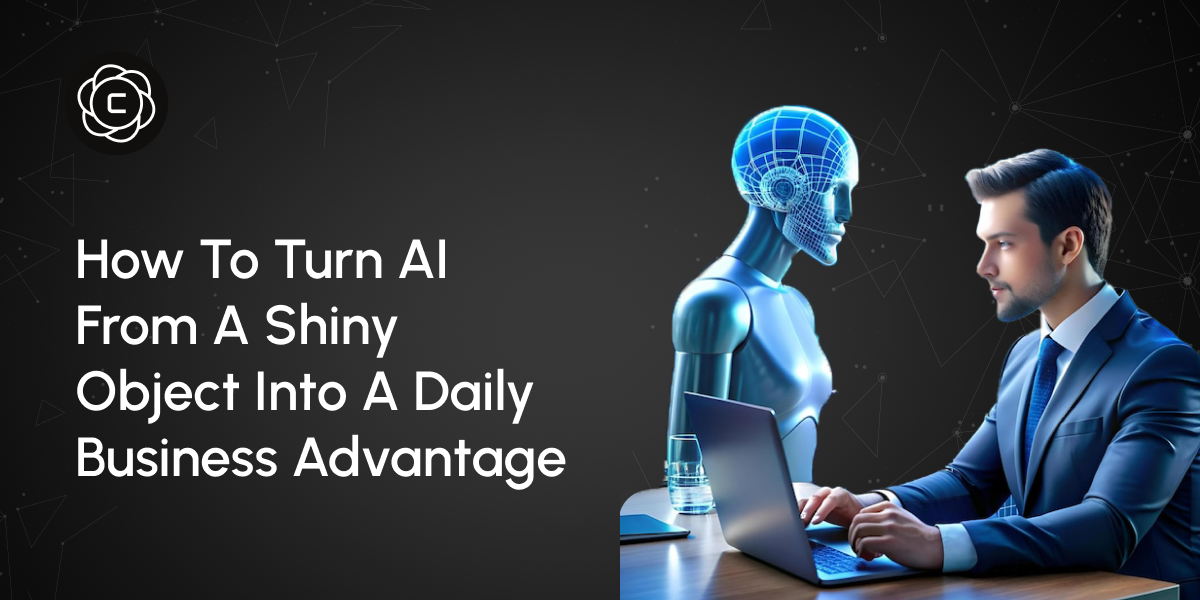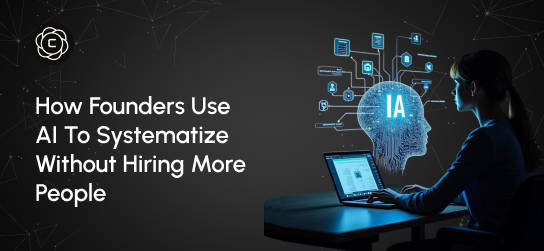LearningCenter
Master AI creativity with our comprehensive guides, tutorials, and expert insights. From beginner basics to advanced techniques.
How to Turn AI From a Shiny Object Into a Daily Business Advantage

Introduction
Six months ago, I watched a business owner spend $500 on an AI subscription, use it twice, then abandon it entirely. Last week, that same founder asked me which “AI tools actually work.” It’s a pattern I’ve seen repeatedly. Leaders sense that AI can offer leverage, but they approach it like a trend, something to try, not something to implement. The difference between AI as a curiosity and AI as a core business advantage isn’t about tools. It’s about integration. The companies pulling ahead aren’t using more AI. They’ve embedded it into the systems they already rely on, so deeply that removing it would break operational flow.
Why Most AI Implementations Fail
The biggest misstep? Treating AI like a software purchase. License a tool, assign an owner, and hope it transforms how people work. But AI isn’t plug-and-play. Its value isn’t in intelligence. It’s in consistent execution.The Novelty Trap
Leaders often begin with AI’s flashiest features. They prompt ChatGPT for a full strategic plan or ask an image generator to design an entire campaign. When results underwhelm, they write off AI as “not ready.” But this approach skips where AI delivers most value: removing the routine burdens that slow teams down every day.The Tool Collection Problem
Buying more tools doesn’t equal better results. I’ve seen teams with a dozen AI apps—and no workflow improvements to show for it. In contrast, one well-placed automation that saves 30 minutes a day will outperform ten unused features every time.The Delegation Without Direction Issue
Leaders often hand off “AI exploration” without structure. The team experiments, dabbles, then moves on when nothing sticks. Without clarity on where AI fits, what success looks like, or how it should integrate with existing systems, even motivated teams can’t generate momentum.The Strategic Integration Framework
High-performing AI adoption doesn’t begin with tools, it begins with operations. The focus isn’t what AI can do. It’s where it can consistently support what already matters. Instead of chasing AI capabilities, strategic teams map the workflows first, then layer in automation where it makes a measurable difference. Process Mapping Before Tool Selection: Every successful AI rollout starts with detailed workflow diagnostics. The goal is to surface where time leaks, bottlenecks, and predictable decisions slow down execution. Once you see the friction clearly, it becomes obvious where AI can add lift without disrupting the system. Take customer support: high-frequency inquiries, escalation patterns, and resolution paths are already structured. That structure is where AI performs best. Incremental Integration Over Complete Automation: Strategic teams don’t try to automate everything from day one. They start small—targeting the highest-leverage step, not the full process. This phased approach builds confidence and clarity. A marketing team might begin by using AI to test subject line options. Once they see results, they expand into drafting full emails, then campaign design. Each stage earns its place through proof, not pressure.Measurement and Refinement Systems
Smart companies treat AI like any other operational system, it gets monitored, refined, and optimized over time.This means tracking real outcomes: minutes saved, conversion lift, error reduction not vague satisfaction with the tool.
If AI saves 10 hours a month on repetitive tasks or improves campaign quality scores, that becomes your signal for what to scale next.
Building Your Daily AI Advantage
Begin with Communication Efficiency
Much of your team's day is spent composing updates, drafting responses, and formatting documents. These are structured, repeatable tasks—perfect for AI optimization.
Tools like Crompt’s Email Assistant streamline standard communication flows so your team can focus where human input matters most: relationship context, strategic insight, and decision-making.
It’s a small shift that compounds across your entire operation—saving time, preserving energy, and increasing signal.
Sustainable Content Systems
Content shouldn’t depend on inspiration or available hours. With the right AI integration, your team can maintain consistent output—across blogs, product updates, and campaigns—without creative fatigue.
The result is steady engagement, aligned messaging, and a system that doesn’t stall when workloads spike.
Operational Load Reduction
Routine tasks like scheduling, formatting, and data standardization drain bandwidth from more valuable work. Let AI take the first pass on admin-heavy tasks, freeing your team for higher-order execution.You reduce friction without compromising oversight.
Faster Insight, Better Reporting
Traditional reporting cycles burn hours and often deliver late-stage insight. AI shifts this by surfacing patterns, anomalies, and implications in real-time.
With tools like Crompt’s Business Report Generator, what used to take hours now takes minutes—giving your team more time to act on the insights, not assemble them.
Creating Systematic Implementation
The 30-Day Integration Cycle
Effective AI implementation follows a repeatable cycle: select one process, deploy support, evaluate impact, refine the approach, and expand deliberately.Week 1: Map the process and select appropriate tools
Week 2: Launch initial implementation and begin testing
Week 3: Optimize for quality and operational fit
Week 4: Measure performance and define the next application
This structure prevents the common trap of tool accumulation without true integration.
Quality Control and Brand Consistency
Maintaining standards with AI requires more than occasional review. Build systems that uphold brand integrity across outputs. This includes review checkpoints, style parameters, and escalation thresholds.Tools like Crompt's Grammar and Proofread Checker function as quality control layers—ensuring content stays aligned with professional expectations at scale.
Team Training and Adoption
Real integration depends on more than access. It requires alignment. Equip teams with not just technical instructions but real examples of where, when, and why AI delivers value.
Prioritize practical relevance over technical theory. Focus on workflows, not features.
Measuring Real Business Impact
Time-Based Metrics
Start by quantifying time saved across core processes. Benchmark pre- and post-AI performance on measurable tasks.Key areas to watch:
-
Email drafting and response handling
-
Content generation cycle time
-
Research and synthesis speed
-
Admin turnaround time
-
Support ticket resolution pace
These metrics validate value and shape the next phase of integration.
Quality and Consistency Improvements
Even without dramatic time reductions, AI can lift baseline consistency. Track error reduction, content coherence, and customer satisfaction indicators to surface quality gains.Revenue and Cost Impact
Strategic ROI shows up in top and bottom lines. Trace how AI influences revenue through output scale or cost reduction through operational efficiency.Scalability Advantages
Assess how AI affects your ability to serve more customers or handle higher work volume without expanding headcount or introducing complexity.Advanced Integration Strategies
Cross-Process Optimization
When individual systems stabilize, connect them. Compound benefits emerge when outputs from one workflow fuel inputs for another.Example: content creation → AI-powered scheduling → AI-led engagement analysis.
Custom Workflow Development
Advanced teams layer multiple AI tools into integrated sequences tailored to specific processes.
Crompt's Task Prioritizer helps identify where chained workflows offer the highest returns.
Predictive and Strategic Applications
Once operational support is in place, elevate toward insight generation; market sensing, behavior forecasting, and competitor tracking.These applications don’t replace foundational systems. They build on them.
Avoiding Implementation Pitfalls
Technology Over Strategy Focus: Don’t lead with features. Lead with business needs. Align AI use to concrete problems, not generalized capability.
Perfectionism Over Progress: Momentum beats ideal conditions. Let small wins compound. Precision improves with exposure.
Isolation Over Integration: Siloed tools underperform. Embed AI into your workflows so it reinforces—not bypasses—your systems.
Your Competitive Advantage Timeline
A year from now, most businesses will fall into one of two groups:→ Those who built AI into how they operate
→ And those still “testing” what might work
To land in the first group, pick one routine process. Implement with Crompt. Track the results. Refine.
No hype. No shortcuts. Just sustained advantage through intelligent design.
The transformation doesn’t begin with a breakthrough.
It begins with your first repeatable win.
Table of Content

Your Calendar Is Not Broken (Your Mental Operating System Is)
Last month, I watched a founder spend three hours reorganizing his calendar app for the fourth time this year. Different colors, new categories, smarter blocking strategies. By week two, he was back to the same chaotic pattern: overcommitted, constantly running late, and feeling like his day controlled him instead of the other way around. The problem wasn't his calendar. It was the mental operating system running underneath it. Calendar issues aren’t about tools; they’re about how you think about time. They download new apps, try productivity methods, and wonder why nothing sticks. Meanwhile, the real issue sits in how their brain processes time, priorities, and commitments.

How to Combine Human Thinking and Generative AI for Smarter Outcomes
Last Tuesday, I watched two product managers go head-to-head on the same challenge. Same tools. Same data. Same deadline. But the way they used AI couldn’t have been more different and the results made that difference unmistakable. One delivered a generic solution, familiar and easily replicated. The other crafted a proposal that felt thoughtful, grounded, and strategically distinct. Their CEO approved it for implementation within minutes. The gap wasn’t technical skill or AI proficiency. It was their thinking architecture, the way they framed the problem, used AI to explore, and layered in human context to guide the output.

Why Better Generative AI Starts With Better Thinking (Not More Tools)
Four months ago, I watched a marketing director spend $400 on AI subscriptions only to produce the same mediocre content she'd always created. Her problem wasn't the tools. It was her approach. This scenario plays out everywhere. Professionals accumulate AI subscriptions like digital trophies, believing more tools equal better results. They're missing the fundamental truth: generative AI amplifies your thinking, not replaces it. The best AI users I know don't have the most tools. They have the clearest thinking processes.
Stay Updated
Get the latest AI insights, tutorials, and feature updates delivered to your inbox.






